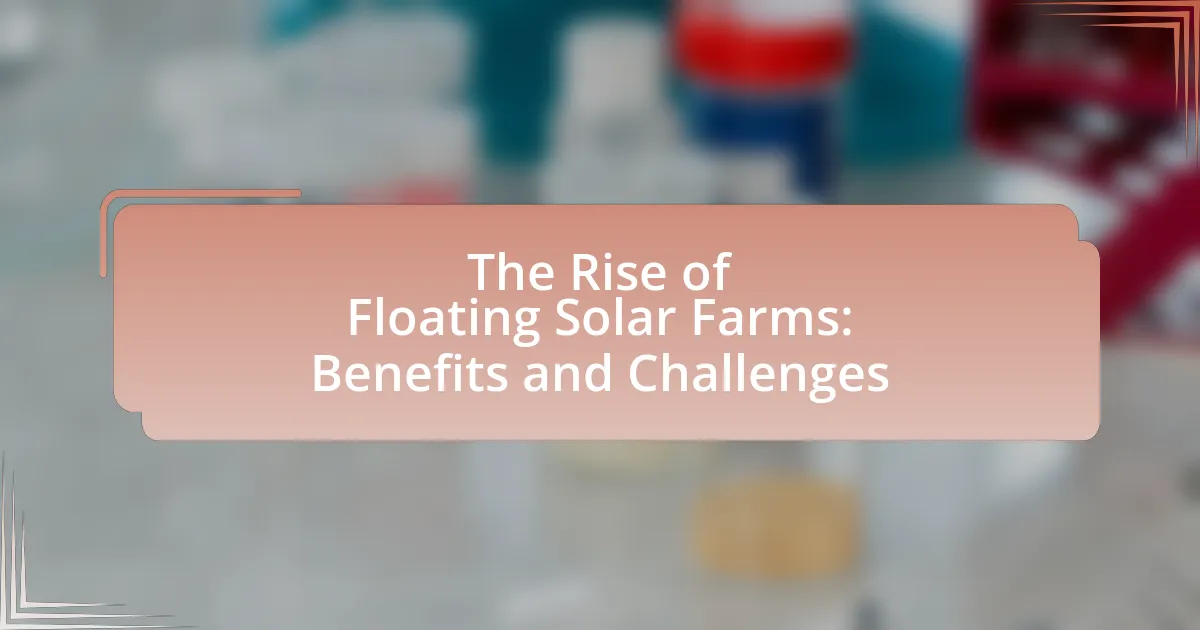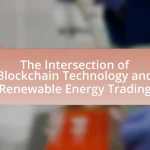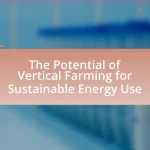Floating solar farms are innovative solar energy installations situated on bodies of water, such as lakes and reservoirs, designed to generate electricity while minimizing land use. This article explores the operational mechanisms of floating solar farms, the technologies involved, and their advantages over traditional solar farms, including enhanced energy efficiency and reduced water evaporation. It also addresses the challenges these installations face, such as high costs and regulatory hurdles, while highlighting successful global implementations and future trends in the sector. The discussion emphasizes the environmental benefits and economic considerations essential for the sustainable development of floating solar technology.
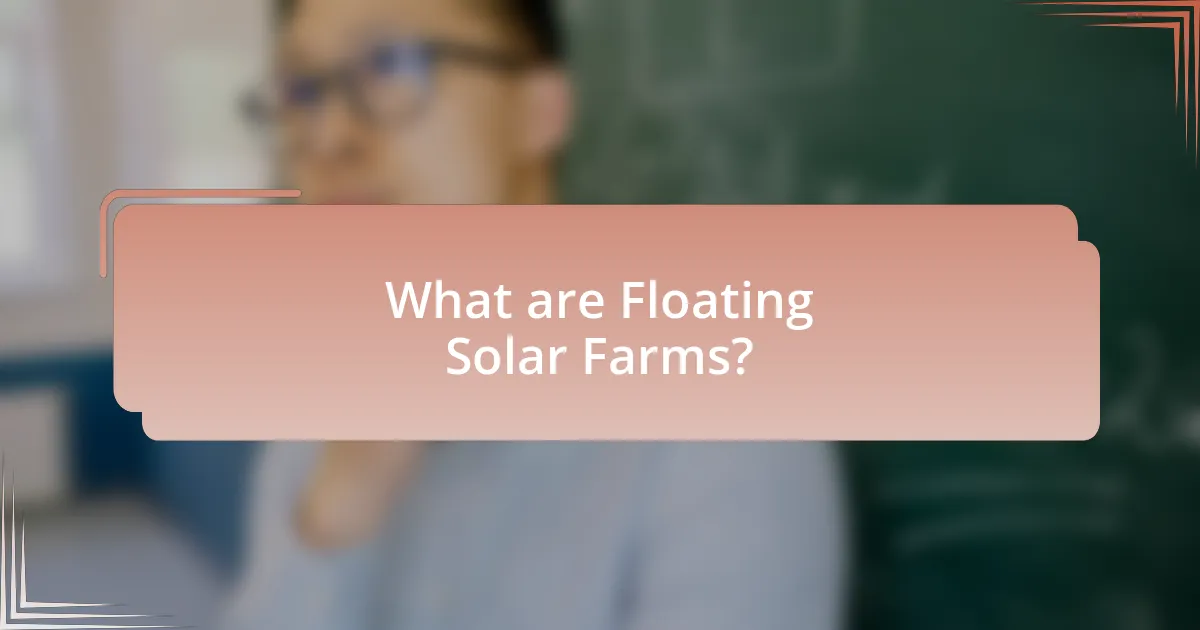
What are Floating Solar Farms?
Floating solar farms are solar energy installations that are built on bodies of water, such as lakes, reservoirs, or oceans. These farms utilize floating platforms to support solar panels, allowing for the generation of electricity while minimizing land use. According to a report by the International Renewable Energy Agency (IRENA), floating solar capacity has been growing rapidly, with over 2.5 gigawatts installed globally by 2020, demonstrating their increasing viability as a renewable energy source.
How do Floating Solar Farms operate?
Floating solar farms operate by utilizing solar panels mounted on floating structures, typically made of durable materials like high-density polyethylene. These structures are anchored to the water body, allowing the solar panels to harness sunlight while minimizing land use. The floating design helps in cooling the panels, which can enhance their efficiency by reducing heat-related energy loss. Additionally, the water surface can reduce evaporation, benefiting the ecosystem. Floating solar farms have been implemented in various locations worldwide, with notable examples including the 40 MW floating solar farm in China’s Huainan City, demonstrating their viability and effectiveness in generating renewable energy.
What technologies are used in Floating Solar Farms?
Floating solar farms utilize several key technologies, including photovoltaic (PV) panels, floating platforms, and anchoring systems. Photovoltaic panels convert sunlight into electricity, while floating platforms, often made from durable materials like high-density polyethylene, support the PV panels on water surfaces. Anchoring systems secure the platforms to prevent movement and ensure stability. These technologies collectively enable efficient energy generation while minimizing land use, as evidenced by projects like the 40 MW floating solar farm in China, which demonstrates the viability and effectiveness of this approach.
How do Floating Solar Farms differ from traditional solar farms?
Floating solar farms differ from traditional solar farms primarily in their installation location, as floating solar farms are situated on bodies of water, while traditional solar farms are typically installed on land. This unique positioning allows floating solar farms to reduce land use conflicts, minimize evaporation from water bodies, and potentially increase energy efficiency due to the cooling effect of water. According to a report by the International Renewable Energy Agency, floating solar installations can achieve higher energy yields compared to land-based systems, particularly in hot climates, due to lower operating temperatures.
What are the key benefits of Floating Solar Farms?
Floating solar farms provide several key benefits, including efficient land use, reduced water evaporation, and enhanced energy production. By utilizing water surfaces, floating solar farms minimize the need for land, which is particularly advantageous in densely populated areas or regions with limited available land for traditional solar installations. Additionally, the presence of solar panels on water bodies can significantly reduce evaporation rates, conserving water resources in arid regions. Studies have shown that floating solar installations can achieve higher energy output due to the cooling effect of water, which helps maintain optimal operating temperatures for solar panels. For instance, a report by the National Renewable Energy Laboratory indicates that floating solar can increase energy generation by 10-20% compared to land-based systems under similar conditions.
How do Floating Solar Farms contribute to renewable energy goals?
Floating solar farms contribute to renewable energy goals by harnessing solar power on water bodies, which maximizes land use efficiency and reduces evaporation. These installations can generate significant amounts of electricity, with some projects producing over 1 GW of power, thereby directly contributing to the reduction of greenhouse gas emissions. Additionally, floating solar farms can enhance energy generation efficiency due to the cooling effect of water, which can increase solar panel output by up to 10%. This innovative approach supports global renewable energy targets by diversifying energy sources and promoting sustainable practices in energy production.
What environmental advantages do Floating Solar Farms offer?
Floating solar farms offer significant environmental advantages, including reduced water evaporation and improved water quality. By covering water surfaces, these solar installations minimize evaporation rates, which is particularly beneficial in arid regions where water conservation is critical. Additionally, floating solar panels can help reduce algae growth by blocking sunlight, thereby improving the overall quality of the water. Studies indicate that floating solar can decrease evaporation by up to 90% in some cases, making it an effective solution for water management while simultaneously generating renewable energy.
What challenges do Floating Solar Farms face?
Floating solar farms face several challenges, including high installation costs, maintenance difficulties, and environmental concerns. The initial investment for floating solar technology is often higher than traditional land-based solar systems due to specialized materials and anchoring systems required for stability on water bodies. Maintenance can be complicated by the inaccessibility of floating structures, which may require specialized vessels or equipment for repairs and cleaning. Additionally, environmental concerns arise regarding the impact on aquatic ecosystems, such as potential disruption to local wildlife and water quality. These challenges must be addressed to ensure the sustainable development of floating solar farms.
What are the economic challenges associated with Floating Solar Farms?
Floating solar farms face several economic challenges, primarily related to high initial capital costs and ongoing maintenance expenses. The installation of floating solar panels requires significant investment in specialized infrastructure, which can be more expensive than traditional land-based solar farms. Additionally, the maintenance of these systems can be complicated by factors such as water quality, wave action, and potential algae growth, leading to increased operational costs. According to a report by the International Renewable Energy Agency, the cost of floating solar installations can be 10-20% higher than that of ground-mounted systems, impacting the overall economic viability of such projects. Furthermore, securing financing can be difficult due to perceived risks associated with new technologies and regulatory uncertainties, which can hinder investment in floating solar initiatives.
How do regulatory issues impact the development of Floating Solar Farms?
Regulatory issues significantly impact the development of floating solar farms by influencing project feasibility, permitting processes, and compliance costs. These regulations can vary widely by region, affecting how quickly projects can be initiated and completed. For instance, stringent environmental assessments may delay approvals, while favorable policies, such as renewable energy incentives, can accelerate development. According to a report by the International Renewable Energy Agency, regulatory frameworks that support renewable energy can lead to a 30% reduction in project costs, highlighting the importance of favorable regulations in promoting floating solar technology.
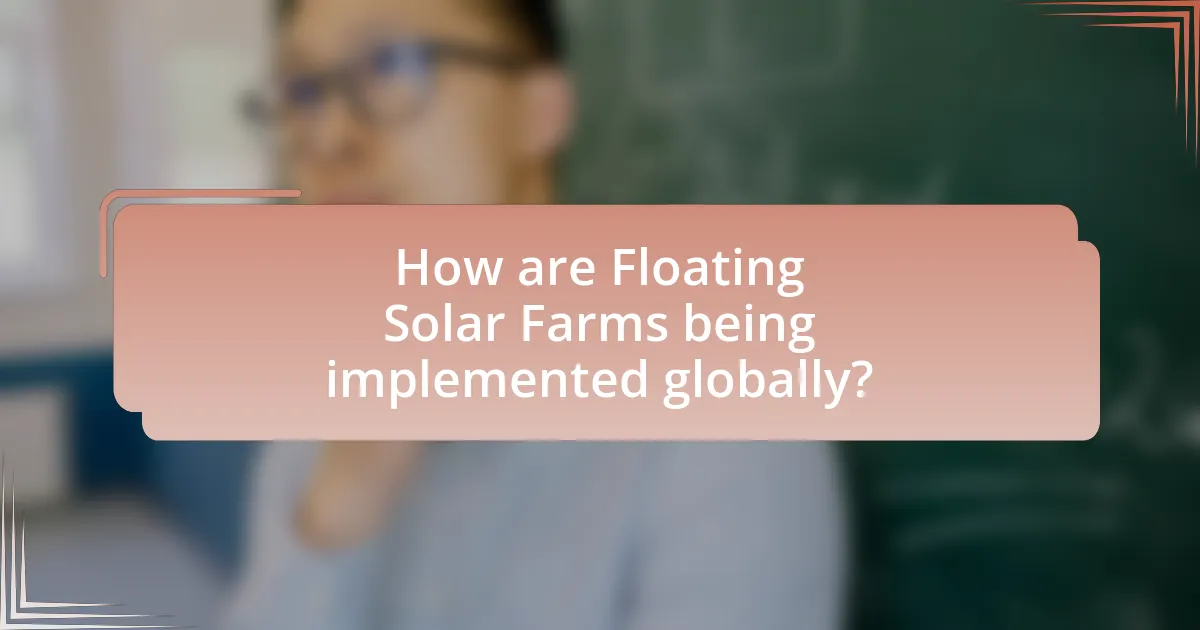
How are Floating Solar Farms being implemented globally?
Floating solar farms are being implemented globally through various projects that utilize bodies of water, such as lakes, reservoirs, and coastal areas, to install solar panels. Countries like China, Japan, and India have led the way, with China alone having over 2,000 floating solar installations, contributing significantly to its renewable energy targets. In Japan, floating solar farms are being deployed to maximize land use and reduce competition with agriculture, while India is focusing on utilizing its vast water bodies to enhance energy generation without occupying valuable land. These implementations are supported by advancements in technology, regulatory frameworks, and increasing investments in renewable energy, demonstrating a growing trend towards sustainable energy solutions worldwide.
What countries are leading in Floating Solar Farm projects?
China, India, and Japan are leading countries in Floating Solar Farm projects. China has the largest floating solar capacity in the world, with significant installations such as the 40 MW project in Huainan. India follows with notable projects like the 600 MW floating solar plant in the state of Madhya Pradesh. Japan also contributes to this sector with various floating solar initiatives, including the 13.7 MW project in Yamakura. These countries are at the forefront due to their investments in renewable energy and innovative approaches to utilizing water surfaces for solar energy generation.
What lessons can be learned from successful Floating Solar Farm implementations?
Successful Floating Solar Farm implementations demonstrate the importance of site selection, which significantly impacts energy generation efficiency. For instance, choosing locations with minimal shading and optimal water surface area can enhance solar capture, as evidenced by projects like the 40 MW floating solar farm in China, which reported a 15% increase in energy output compared to land-based systems. Additionally, effective engineering and design tailored to local environmental conditions, such as wind and wave resistance, are crucial for long-term sustainability. The 2019 study by the National Renewable Energy Laboratory highlighted that robust anchoring systems can reduce maintenance costs and improve operational lifespan. Furthermore, stakeholder engagement and regulatory compliance are essential for project success, as seen in the successful deployment of floating solar in Japan, where local communities were involved in the planning process, leading to higher acceptance and support.
What are the future trends for Floating Solar Farms?
Future trends for floating solar farms include increased adoption due to technological advancements, cost reductions, and environmental benefits. As of 2023, the global floating solar market is projected to grow significantly, with estimates suggesting a compound annual growth rate (CAGR) of over 20% through the next decade. This growth is driven by innovations in solar panel efficiency and buoyancy systems, which enhance the viability of floating installations in various water bodies. Additionally, floating solar farms are increasingly recognized for their ability to reduce water evaporation and improve water quality, further incentivizing their deployment in regions facing water scarcity.
How is technology evolving to enhance Floating Solar Farms?
Technology is evolving to enhance floating solar farms through advancements in materials, design, and energy efficiency. Innovations such as lightweight, durable floating platforms made from high-density polyethylene and advanced solar panel technologies, including bifacial panels that capture sunlight from both sides, are increasing energy output and reducing costs. Additionally, the integration of artificial intelligence and IoT (Internet of Things) for real-time monitoring and maintenance optimizes performance and extends the lifespan of these systems. According to a report by the International Renewable Energy Agency, floating solar capacity has grown significantly, with over 2.5 gigawatts installed globally by 2020, demonstrating the effectiveness of these technological advancements in increasing renewable energy generation.
What role will Floating Solar Farms play in future energy strategies?
Floating solar farms will play a significant role in future energy strategies by providing renewable energy solutions that maximize space utilization and reduce water evaporation. These installations can be deployed on bodies of water, which allows for the generation of solar power without competing for land resources, thus addressing land scarcity issues. According to a report by the International Renewable Energy Agency (IRENA), floating solar capacity could reach up to 400 gigawatts globally by 2030, highlighting its potential impact on energy diversification and sustainability. Additionally, floating solar farms can enhance energy efficiency by cooling the solar panels, leading to higher energy output compared to traditional land-based solar farms.
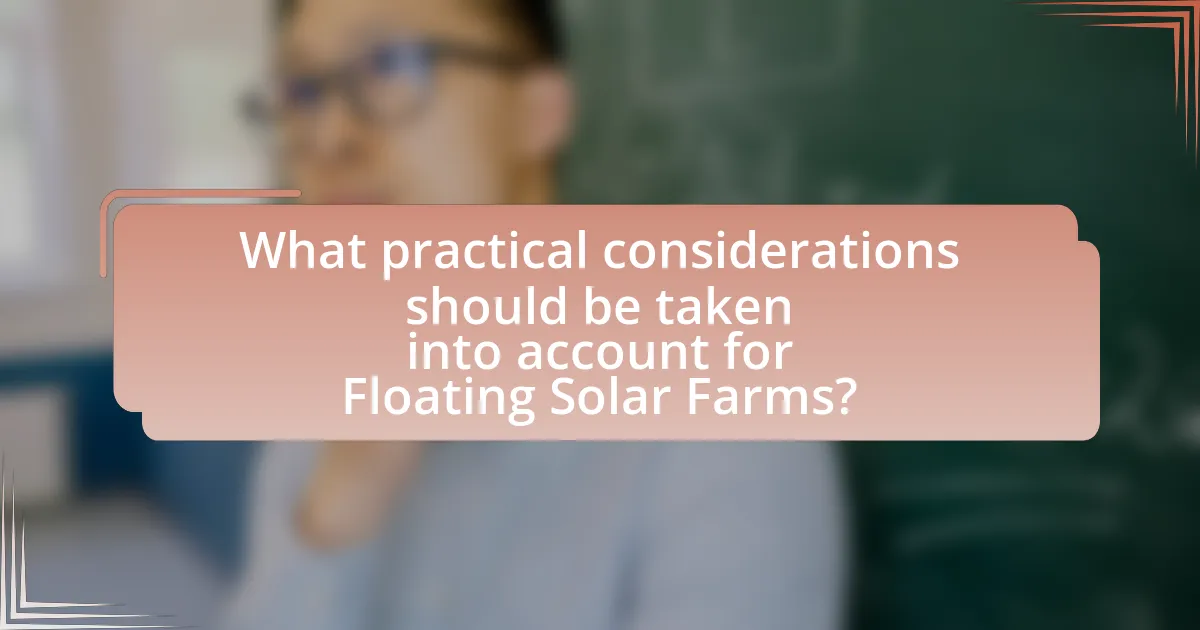
What practical considerations should be taken into account for Floating Solar Farms?
Practical considerations for floating solar farms include site selection, structural integrity, environmental impact, and maintenance accessibility. Site selection must account for water depth, wave action, and proximity to existing power infrastructure to ensure efficiency and safety. Structural integrity is crucial, as floating platforms must withstand harsh weather conditions and potential water level fluctuations. Environmental impact assessments are necessary to evaluate effects on aquatic ecosystems and water quality. Lastly, maintenance accessibility is vital for ensuring the longevity and performance of the solar panels, requiring planning for easy access to the floating structures for repairs and cleaning.
What are the best practices for designing Floating Solar Farms?
The best practices for designing floating solar farms include selecting suitable water bodies, ensuring structural stability, and optimizing energy output. Suitable water bodies should have minimal wave action and be deep enough to accommodate floating structures without interference. Structural stability is crucial; designs must withstand environmental factors such as wind, waves, and potential flooding. Optimizing energy output involves strategic placement to maximize sunlight exposure and considering shading effects from nearby structures or vegetation. Additionally, incorporating materials that resist corrosion and biofouling enhances longevity and efficiency. These practices are supported by case studies showing increased energy generation and reduced maintenance costs in well-designed floating solar installations.
How can potential investors assess the viability of Floating Solar Farms?
Potential investors can assess the viability of Floating Solar Farms by evaluating factors such as site suitability, regulatory frameworks, technology efficiency, and financial projections. Site suitability involves analyzing water body characteristics, including depth, surface area, and proximity to infrastructure, which can impact installation and maintenance costs. Regulatory frameworks encompass local, state, and federal policies that may affect project approval and operational compliance. Technology efficiency refers to the performance of solar panels in aquatic environments, with studies indicating that floating solar systems can achieve higher energy yields due to cooling effects from water. Financial projections should include cost-benefit analyses, return on investment estimates, and potential revenue from energy sales, supported by market trends showing a growing demand for renewable energy sources.
What common challenges should be anticipated when operating Floating Solar Farms?
Common challenges anticipated when operating floating solar farms include environmental impacts, maintenance difficulties, and regulatory hurdles. Environmental impacts arise from potential disruptions to aquatic ecosystems, as floating solar installations can affect water quality and local wildlife. Maintenance difficulties stem from the unique conditions of water bodies, such as wave action and algae growth, which can complicate access and repair efforts. Regulatory hurdles often involve navigating complex permitting processes and compliance with local, state, and federal regulations, which can vary significantly by location. These challenges highlight the need for careful planning and management in the deployment of floating solar technology.
